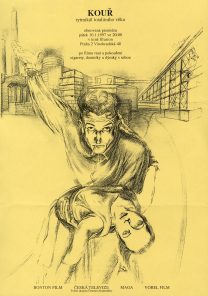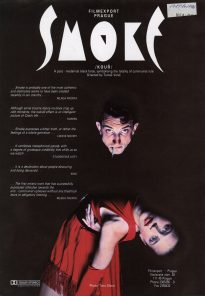The birth of Smoke (with working titles such as ING. 88, Engineer Smokes Clays, Smokers, etc.) is dated to the second half of the 1980s, when it was initialized by the screenwriter Jan Gogola, Sr., impressed by Vorel’s student film ING. He suggested that Vorel should turn the story of the young engineer Mirek who must deal with pressing matters both in his personal and work life into a feature film and convinced him that it would be possible to film such a story in the Gottwaldov Studios. Vorel then began working on his first authorial film, and his friends from the Prague Five theatre group were to help him with setting its tone and atmosphere. With their means of artistic expression, he planned to create the first new age musical – a rhytmical that is characterised by “tantalising rhythm of words and action, stylised gestures, choral recitation, musical performances and self-ironic humour binding everything together.”[1] The genre label that Smoke bore proved to be crucial during pre-production and the approval process. A musical could be interpreted – as we can find in the production explication – as the most folksy genre, which provides the viewer with total fun and is also extremely stylised and thus exaggerated and addressing the reality only indirectly.[2]
In retrospect, we can only hardly imagine that the poetics of the Prague Five could have been in line with the official culture and consumerism of the so-called Normalisation era (1968–1989) and would turn Smoke into a tame folksy musical. But we are talking about the “glasnost” era that was open to other films with daring themes exploring formerly taboo topics, such as Bony and Peace (Bony a klid) and An Uncertain Season (Nejistá sezóna) – both of which premiered in 1988 – and it can be said that the time of its production spoke in favour of Smoke. The result was as expected – the rhytmical turned the rules of classical musicals upside down. It is set in a dark, smoky factory and instead of pleasant feelings and sentimentality it evokes unease, and instead of kind humour it makes us laugh through ironic and absurd humour. The song lyrics written for Smoke by Lumír Tuček, the author of theatre plays of the recitation group Vpřed (who also helped to write the film’s script), are usually not sung but rather recited (or rapped) to a cacophonous mixture of saxophone, flute, synthesizers and even an eaves pipe and a can.
The non-traditional soundtrack and the “inappropriate” setting shape also other formal elements of the rhytmical. The characters do not perform elegant choreographies, but at times rather stagger, at other times jerk their bodies and rapidly jump and run without ever being permitted to leave the industrial setting of the factory. Singing doesn’t open gates to a surreal world of fantasy and dreams – although the characters do enter this world in a scene when alcohol (or dry ice?) turns a celebration of International Women’s Day into a Dionysian hallucinogenic party. The general impression of the distorted world of Smoke is enhanced by the work of cinematographer Martin Duba and his work with light. Despite frequent close-ups of the characters’ faces, we don’t get to read their expressions as they are in the dark or semi-dark. This technique corresponds to the colour pallet significantly reduced to monochromatic surfaces of grey and blue and sometimes supplemented by striking red and black elements. Vorel and his co-authors indeed managed to concentrate all the filth and smoke of socialist public institutions into the factory-city, where there is no difference between your home and workplace, where you can barely breathe and can hardly stay, where scarce patches of green hide under layers of old documents. And all that labelled as a musical, “the most utopic of all forms that Hollywood ever released into the world.”[3]
The development of Smoke was very complicated. First of all, it had to be moved from the Gottwaldov Studios to the Barrandov Studios to the First Dramaturgical Group of Jiří Blažek. No official reason was stated. Blažek claimed it was due the financial aspects of the project, but in reality – according to Vorel and Gogola – it was a reaction to Vorel’s signature of the petition Několik vět (A Few Sentences).[4] The preproduction (mainly various rehearsals) started in late October 1989 and ended in January 1990, which means that fundamental changes in society happened during the preproduction. The authors thus had to change “only” their ending. Instead of the originally planned simple happy ending, they killed off the character of the General, the head of the factory, and made the film’s main hero, Mirek, kill his incompetent boss loyal to the system, ing. Šmíd. Concurrently, a social revolution breaks out and the factory inhabitants sweep the streets chanting, “It is worth it!” But Vorel didn’t succumb to one-sided optimism. He let the character of Mirek get arrested (understandably) for murder and. in the film’s last scene, shows the old elites quickly joining the newly established society and chanting the same things.
Smoke premiered a year after that, on 1 February 1991. From the box office point of view, it wasn’t much of a success, probably for more reasons. Whether one of them was the overflow of American production in distribution – as Vorel says – is debatable, since the number of foreign films had been increasing gradually already since the second half of the 1980s, and statistics show that Czech audiences didn’t lose their interest in domestic films. The blame lies probably in a combination of a change in lifestyle, new possibilities of spending leisure time, and chiefly weak promotion of the film, something that Vorel also mentions.[5] With its 51,300 viewers, Smoke was not a box office hit, but in due time (and also thanks to the help of a re-run in cinemas six years later) it became something unique within the Czech film industry – a cult film. Not a famous and popular film, but rather a film that was at first ignored only to be rediscovered later and subsequently popularized by its passionate viewers and fans.
Jan Bergl
Notes:
[1] Barrandov Studio a.s., archive, collection: Scénáře a produkční dokumenty, Film: Kouř, Vorel, T: Realisation explication, p. 3.
[2] Ibid.
[3] Kamil Fila, Ujeté muzikály. Cinema, 2006, no. 5, p. 63.
[4] It is possible that it was a different petition, as Tereza Štréglová points out on page 32 of her bachelor’s thesis The Smoke: Origin and further fate of Tomáš Vorel’s first film
[5] Both in an interview for a Bontonfilm issued DVD of Smoke in 2005.



